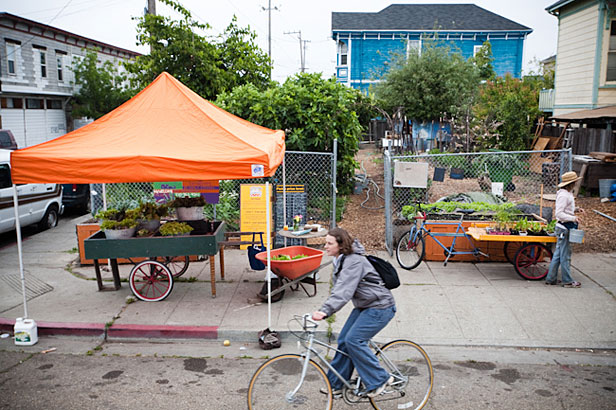 One of City Slicker Farms’ tiny but productive sites in West Oakland, Calif. Much of the produce is grown vertically, to maximize space, and there’s a chicken coop tucked in the back corner. Photo: Courtesy of Anne Hamersky, from the forthcoming book Farm Together Now
One of City Slicker Farms’ tiny but productive sites in West Oakland, Calif. Much of the produce is grown vertically, to maximize space, and there’s a chicken coop tucked in the back corner. Photo: Courtesy of Anne Hamersky, from the forthcoming book Farm Together Now
Oakland, Calif., where I live, doesn’t have a lot to celebrate, what with budget-driven police layoffs and an unemployment rate of 11.5 percent. Still, one piece of good news has urban agriculture proponents cheering.
Not about Oakland’s plan to sanction (and tax) large-scale marijuana farms, but the announcement that City Slicker Farms, a leader in urban-farming and food-justice circles, has been given $4 million to buy land on which to farm.
City Slicker got its start in 2001 on a parcel of borrowed vacant land in the “food desert” of impoverished West Oakland (see Grist’s food-justice story), where 32 percent of residents live below the poverty level and mortality rates for diabetes and heart disease are well above the county rate. They soon started a “pay what you can” farm stand, and then a program to help residents grow their own food in their back yards. Today, City Slicker Farms operates seven Community Market Farms, more than 100 backyard gardens, a greenhouse, and Urban Farming Education programs. It grows 20,000 pounds of food annually.
And soon, with state money, City Slicker will be purchasing a 1.4-acre parcel in West Oakland, the vacant, fenced-off former site of a paint factory that has undergone a thorough brownfield cleanup. On it, it will plant and construct what it’s calling the “West Oakland Urban Farm and Park,” which after extensive consultation with area residents will contain lawn space (for kids to run, play, and exercise), a vegetable-growing area, a community garden, a fruit orchard, a chicken coop, a beehive, a dog run, and a tot lot. It will be free and open all day, seven days a week.
The funds come from Proposition 84, a 2006 California bond initiative that earmarked $5.4 billion for statewide park development and community revitalization. It’s amazing that what was once an eyesore will become a living, growing green space that will provide fresh food and sanctuary to a community that has very little of either.



